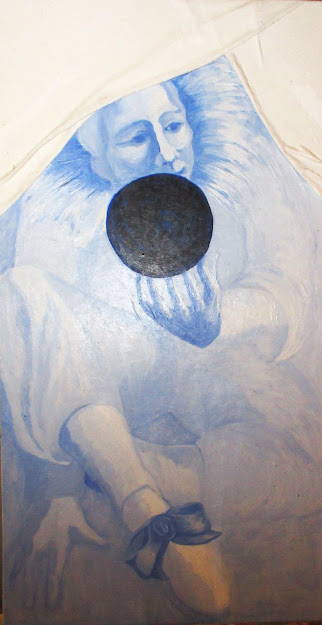These witchy gals keep showing up in my searches for vintage photos – sans identification. Well, what would one expect? And who would want to learn that one of them was your grandmother?
Even in their day, they were youngsters in the witchly family tree. The first known written manual on How To Be A Witch dates to 1584, but the practice evidently goes back to the Stone Age in different cultures.
This group of pointy-hatted Victorians would be right at home having tea in the garden. Oops!! That's a Starbuck's cup, and someone who is decidedly eerie has already snagged the last table.
Coincidentally with this season when costumes rule, I've been thinking about my next series – after my tronie-induced art fail recorded last time. Looking at old lists I'd made of possible "Series and Singulars," as I call them, I came across a recurring enticement – Commedia dell'Arte. Like the witches' grimoire, there are various recorded fragments of Commedia performances going back to the 1500s.
This ample compendium from the 1960s collected working scripts for no fewer than 50 plotlines.
Thanks to traveling Italian players, the Commedia's stock characters in stock situations will show up throughout the history of European theatre -- in Shakespeare, in Moliere, and even in the lower-brow Punch and Judy puppet shows.
Well! Before my book request came through from the Vancouver Public Library, I'd remembered my early infatuation with the Commedia characters. When we moved in 2012, I'd tried weeding out old paintings but hadn't been able to give up this brief series from 1988. (I look at some of my early paintings and wonder if I wasn't better then than now).
Here's my Harlequin (Arlecchino in the Italian), whose deep purple-violet garments seem to have become even darker over time – while the surface of the glued collage elements has made it almost impossible to get a proper glare-free shot. It's just as well that my original plan, to place our Siamese cat in his arms, didn't pan out.
Next up: "The White Clown," modeled on the Commedia's Pierrot.
I must offer a tip of someone's hat (pointy or otherwise) to Watteau, from whom I borrowed the bow on the shoe.
I was in a very experimental phase then. The White Clown peeks from beneath that drapery because the panel I was painting on had a big corner chip that I had to cover up. And the final piece in the series is perhaps the most successful – except for my timid treatment of the flesh and faces.
Here, Columbina (left) and Arlecchina share a dramatic element of their dresses with the single piece of old lace that unites them.
Well, one thing leads to another when your thoughts are leaping around.
As a result, I've decided to revisit the Commedia characters and costumes. After all, if the subject is good enough for Picasso, it's good enough for me. No way!!! I've just gone looking for a link to Picasso's harlequins and found a link to "Picasso Clown Fish." A pricey little number, too.
So – gather your theatre attire…or popcorn?...and get ready for more behind-the-scene glimpses of a zany collection of characters. But first, they have to audition!













No comments:
Post a Comment